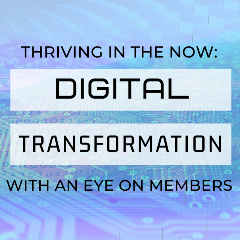How can credit unions differentiate themselves from competitors and not just survive, but thrive, in today’s digitally-driven market? Two words: digital transformation.
Daniel Newman, author of Building Dragons: Digital Transformation in the Experience Economy, provides guidance for credit unions seeking to create a digital transformation strategy. Newman promotes the concept of a new credit union business economy based on development of impactful member experiences.
What is the ‘Experience Economy?’ Why are credit unions moving to it?
The Experience Economy asks us to understand the seamless experience members are seeking that simplifies and unifies previously disconnected activities. It also allows credit unions to create separation from competitors, assume an industry leadership role, and establish greater member trust. 
Organizations that realize the world is shifting to a digitally-driven, experience-oriented economy are making adjustments by adapting and innovating. Through their digital transformations, they become disruptors, rather than laggards and followers. History shows that laggards, having been challenged by digital disruptors, are eventually eliminated or greatly diminished. This reinforces the notion that digital transformation is critical to a credit union’s long-term success in today’s ever-evolving financial services environment.
How can you adapt, innovate and adjust your organization to meet the challenge?
A credit union seeking to compete in today’s Experience Economy must adapt to the digital environment. It may require adjusting operations, technologies and workplace culture. Organizational leaders set the agenda for digital transformation and should consider the cultural pace of change now necessary as a direct result of innovation and rapid business change. Ultimately, digital transformation requires a blend of people, process and technology adjustments to succeed.
Newman recommends that organizations determine whether they will take a defensive approach – and survive by following digital disruption – or an offensive approach – and become the disruptor. Credit unions may want to consider how their business needs to adapt through a “business-first” set of goals, deploy technology capabilities to support these goals, and continually cycle through changes on the horizon.
What steps can help credit unions create an impactful member experience?
Always think “business first.” Understand your members, and through journey maps, consider the experiences they have with your products and services. Evaluate how improvements to their experiences will help them do business more effectively across your organizational functions.
Digital Transformation can be accomplished through five phases, according to Newman:
- Phase 1: Experience as a platform – create a digital purpose and vision, with an accompanying digital transformation journey. Ensure your credit union is aware of the experience changes that lie ahead and why they’re critical to success.
- Phase 2: Digital assimilation – create a business plan outlining the necessary personnel and innovative technology components that can make the new experiences a reality.
- Phase 3: Seamless technology enablement – integrate new technologies, including mobility, big data, Internet of Things (IoT), blockchain and cognitive computing via artificial intelligence and machine learning.
- Phase 4: Outcome acceleration – credit unions typically have robust data stores that are not being utilized to create internal and member insights. Create experiences that leverage the data as a business model.
- Phase 5: Disruption as a business model – Position your credit union to “mature” and become the digital disruptor by establishing internal startups with innovative vendor and technology partnerships. Continue this, and repeat as necessary, through regular adjustments to your member experiences.
While there are no timelines for accomplishing these phases, credit unions should consider the velocity of digital experience improvements relative to current offerings and industry disruption. You will want to establish a pace that can be supported by personnel and technology within your credit union.
Catalyst Corporate is currently undergoing a digital transformation process to enhance member experiences across all products, services and functions. Member journey maps have uncovered new opportunities to unify member experiences, modernize interaction points and introduce new technology capabilities. We are embracing these opportunities through the introduction of such digital capabilities as mobility, blockchain, data analytics, digital approvals and real-time cross function integrations. Members will witness and participate in these new capabilities throughout the new year, as solutions are deployed.
We invite you to join us in the digital transformation process to continue supporting credit union members and the industry’s long-term success in today’s Experience Economy.